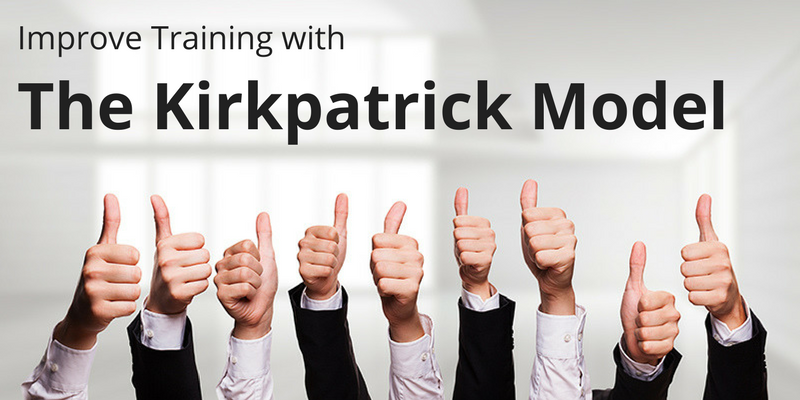
This is part six of our Kirkpatrick Model series, by Hannah Brenner, in which we explore how to measure the results of training evaluation. If you haven’t yet, check out part one here, part two here, part three here, part four here and part five here.
Putting it all together
Throughout this series, we’ve been talking about Kirkpatrick’s Four Levels of Evaluation in reverse. We stayed true to the foundational principle that the end is the beginning and focused our efforts first on results, followed by behavior, then learning and lastly reaction. By keeping the big picture in mind, we identified how to have organization-wide strategic impact through training initiatives.
For some learning professionals, training evaluation guides every part of their program. Others see the benefits in program evaluation… when they have the time. Then there are those who don’t see the value in evaluating their programs at all and skip it altogether.
To those who don’t evaluate, keep in mind that there are three reasons you should be evaluating training: to improve the program, maximize the transfer of learning into behaviors and results, and to demonstrate the value of training to the entire organization.
Strategic impact of training
When we say “demonstrating the value of training” what we mean is return on investment (ROI). This is nothing new, training professionals often use ROI to justify the value of the training program.
But, as discussed throughout this series, many times trainers only use level 1 and 2 data, presenting to leaders items such as the cost per course, participant evaluation results, and the number of people enrolled. In a way, this is showing a return on financial investment – training is being broken down into dollars and cents – but this information does not give an accurate account of organizational value.
This is where Kirkpatrick Partners encourage us to shift our focus.
ROI is a “defensive and reactive tactic that calls for little or no collaboration between training and the business.” Instead of spending time and energy here, trainers should focus more on the Return on Expectations (ROE). ROE centers on the expectations that come with training – it gives data-driven results rather than a simple breakdown of cost.
When thinking about ROE, first ask questions like: What do stakeholders expect to see? What impact is the training meant to have? How is this impacting company strategy? Why is leadership asking for this training? Asking these clarifying questions can move the program beyond ROI and into an entirely new world of demonstrating value.
Finally, when efforts are focused on showing ROE, there is a collaborative effort and sharing of credit with other business units. Instead of everything being about training and what training has accomplished, it becomes about what the business has accomplished through training. Instead of being an island, training can weave itself into all levels of the company, becoming a true business partner.
Uncover key insights about your organization
In our current economy, we’ve heard our fair share about budget cuts, and the effects that budget cuts have within organizations. Too often training is found to be “non-essential” and becomes one of the first programs cut. Jobs are lost and departments are expected to do more with less.
Each and every time this has happened to one of my clients, one factor is the same – level 3 and 4 data were not being reported. The excuses for this are always different, but the result was the same. The training program budget didn’t make the cut.
When done properly, evaluation gives access to data galore. Data that when presented to the right people in the right manner, will demonstrate the value of the training program and how it is essential to the continued success of the organization.
When working to gain leadership buy-in, step one is to know your leader. This is true when it comes to reporting results, as well. Knowing what data matters to each level is essential to reporting the results of your program.
Whereas the Learning and Development/HR department is going to use Level 1 data to improve the program, the same information will be worthless to the department director. He/she will care more about the behavior changes that are being made, your Level 3 data.
Likewise, it would be wasting the executive team’s time with the results of a knowledge test; they are interested in how productivity increased and the savings that followed — Levels 3 and 4.
Now what?
Evaluating training can be a daunting task. But when done correctly, it becomes the most rewarding part of the job. Next time you are presented with the opportunity to design a program, take a step back, take a deep breath, and then tackle it the right way. Ask clarifying questions and then ask some more; understand the bigger picture and have a real impact; refresh yourself on the New World Kirkpatrick Model and use all the resources you have available to design and implement a business-changing program.
BizLibrary clients, you have an entire Client Success team here and ready to help. Our job is to be your partner in training. Trust in us, as we will meet you where you are and help you work through challenges you may be facing.
At BizLibrary, one of our values is to build successful partnerships that last. This means we value relationships with our clients and continuously work to ensure their success. If you are not a client, I encourage you to find out what we’re all about and how we can partner with you in reaching your goals.
For more information on training evaluation, as well as examples of surveys and other tools, check out the Kirkpatrick Partners website at www.kirkpatrickpartners.com or the book Four Levels of Training Evaluation.
Hannah Brenner is a Client Success Consultant with BizLibrary. She discusses training strategies and works with her clients to constantly improve their training program and see a positive return on investment.
